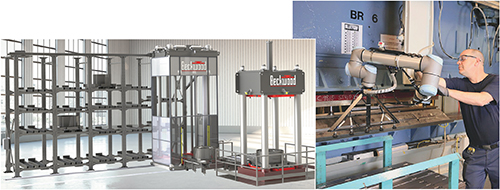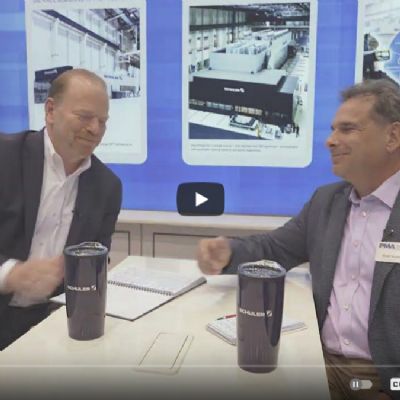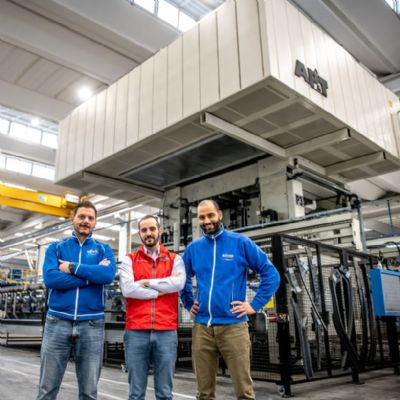“Now, with tool changes occurring multiple times per day in many cases, metalformers cannot accept long changeovers,” says Dixon. “That’s too damaging to their productivity and profitability.” Referencing the above-mentioned example, “Consider a 15,000-lb. tool that a human never has to touch. The automation brings safety gains while increasing efficiency across the board. The press line maintains continuous production as opposed to idling while humans load the next tool. We are seeing a dramatic increase in metalformers asking about QDC.”
2) Robotic Part Loading/Unloading
“Robots commonly are used to automate repetitive tasks and those that would be boring and tiresome to humans,” Dixon says. “The types of robots used vary depending on the application, cycle-time requirements and other specific metalformer needs.”
While traditionalists may believe that robotic part handling requires a fully functional six-axis industrial robot flying around a fully guarded cell, new robot technology offers simplicity and cost savings.
“The recent introduction of collaborative robots, or cobots, provide a lower-cost alternative for applications with less demanding cycle-time requirements,” says Dixon. Although introduced a number of years ago, cobots recently have become more accepted among the manufacturing community.
|
When to Automate? The Rules Have Changed A host of factors determine whether to automate a press line and to what extent. This isn’t news. What is news: Automation makes sense in more situations than it used to. “Most people associate automation with increased speed and throughput, which mostly is true, but automation provides benefits beyond that,” says Josh Dixon, director of sales and marketing for Beckwood Press Co. He notes that safety factors such as repetitive motion, ergonomics and the need to transport heavier weights are, and always will be, prime drivers for automation.Automation traditionally has been applied to processes with well-defined work rules and little variation in parts and procedures. But new technology advancements allow automation to better accept variability. “Some process variability can be overcome through the use of vision systems, sensors and other quality-control devices incorporated into the automation,” Dixon says, while noting that at some point excessive variability will negatively impact ROI. “Also, presses can better interact with automation add-ons, allowing for more seamless and effective integration than ever before. Press builders such as Beckwood deliver presses with compatibility and the ability to expand built in.” Another factor that demands a new look at automation options is cost. “Manufacturers still tend to think that automation often is too expensive,” says Dixon. “What might have been too expensive five years ago is worth checking out again. Increased competition within the industry has resulted in decreased costs, and technology gains have allowed for more ROI-friendly automation than in the past.” This, too, requires metalformers to re-examine automation in their press lines. |
3) Part-Transfer Systems for Progressive Dies
Many metalformers are seeking automated transfer systems for parts, particularly within progressive dies, reports Dixon.
“Each station performs different functions, and automated transfer allows a part to travel quickly through multiple steps within the progressive die,” he explains. “With a linear transfer system, you can move a part efficiently through die stations, allowing the press to cycle as quickly as possible. Automated systems can transfer each part in a single motion, thus providing quick transfer and press-cycle times. Many metalformers continue to rely on hand-transfer, but automated transfer can boost productivity significantly while improving operator safety.”
4) Quality ControlAnother area of demand among metalformers is press-line quality-control, with automated systems integrated into a press itself.
“The increasing image quality of industrial cameras generates a clearer view of part details by vision systems,” Dixon says. “Presses today can be equipped with vision systems that closely monitor parts as they exit the press, checking dimensions and looking for cosmetic defects or checking that a part is properly oriented for processing in a secondary operation. These automated quality-control systems are unbiased, repeatable, and can check parts in milliseconds without increasing production time.”
5) Machine Monitoring and Reporting
Though not normally considered as automation, machine monitoring and reporting most definitely can increase press-line productivity.
“Metalformers require more control over their processes than ever before,” says Dixon. “To get that control they need data, but gathering data is not enough.”
He believes that mountains of data without context cause many metalformers to fall off of the Industry 4.0 and IoT bandwagon.
“A machine can provide any kind of data that you want,” Dixon explains, “but how you analyze and react to that information is what’s important. Press builders such as Beckwood partner with control providers to supply smart machines that not only compile but analyze data and report the information in digestible formats that can result in quick action from plant management."
Machines can track many things including productivity, part quality and downtime.
“For example,” says Dixon, “on a Beckwood press, downtime data could include operator-supplied reasons for downtime as well as machinery production logs over a specified period of time. Results are sent proactively to management where the data are analyzed to uncover the source of the inefficiency such as material shortage, inefficient operators, maintenance issues, etc. It’s not just numbers in an Excel file; it’s actionable intelligence.”
Such information pays dividends in many ways.
“How do you justify to your boss the need to automate die changes?” Dixon asks. “It’s much easier if you have a year’s worth of data showing 800 hr. of lost production due to die changes, as in the case of our QDC example.”
Predictive maintenance is another area where smart machines shine.
“Take the case of a heated platen press,” Dixon offers. “These presses employ multiple electric heating rods with elements that periodically must be replaced. Traditionally, the operator would only become aware of a faulty element by performing temperature checks on a platen or recognizing that part quality was diminishing. That’s an inefficient, reactive way of discovering an issue. From there, the operator would contact the maintenance department, which would have to troubleshoot to find the cause, then contact the machine OEM for a replacement part. It’s a long, drawn-out process.”
A predictive-maintenance system, like Beckwood’s PPM, offers Dixon, eliminates that lengthy process.
“Using integrated machine intelligence such as this, presses can pinpoint the issue, notify the operator, maintenance personnel and machine OEM, and identify the replacement part needed,” says Dixon. “This streamlines maintenance issues and increases machine uptime.” MF
See also: Beckwood Press Company
Technologies: Pressroom Automation, Stamping Presses, Tooling









 Video
Video
